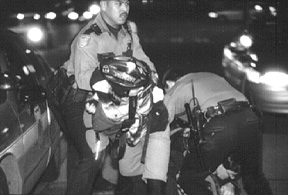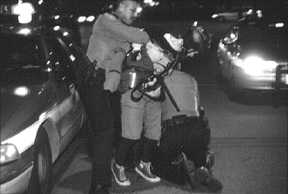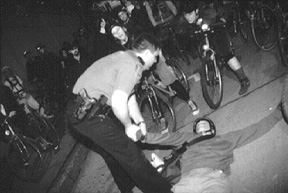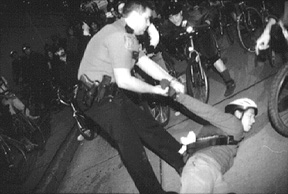



|
The cyclists remained at an arm's length from Myers, many demanding to know reasons for the arrest. Other than verbal taunts, the cyclists remained at bay. As an army of police arrived at the scene, onlookers saw officers chasing and tackling some of the congregated riders.
The situation escalated. One witness, stranded in a Metro bus wedged between the crowd and arriving police cars, saw two arrests. In one instance, several police threw a rider across the hood of a squad car and rifled through his messenger bag. Another was hog-tied with plastic restraints and carried away by a group of officers. Over the course of the evening, five cyclists were arrested and charged with crimes including felony assault on a police officer [editor's note: some charges have been dropped, but most still remain at press time]. All were messengers, despite the fact that messengers comprised less than half of the Critical Mass on that evening.
As cyclists left the scene, several hacked from the fumes of pepper spray used by police to disperse the retreating crowd.
Why did police feel compelled to use force? Police policy justifies force only in the following necessary circumstances: defense of self or another individual; performance of a legal duty, e.g. providing for public safety or enforcing the law; and controlling mentally incompetent or intoxicated individuals (Section 1.145 of the Policies and Procedures manual).
Not a single individual I spoke to noted seeing cyclists strike or otherwise assault any officers. Police reports contradict the scene shown in photos at numerous junctures. Eyewitnesses included employees of the Sorrento Hotel and a Seattle University student as well as Critical Mass riders. No witnesses indicated fear for their personal or the public safety. No one in the group appeared even remotely mentally incompetent or intoxicated.
The Critical Mass riders who I met were decidedly not threats to the community. Bob Kubiniec works with programs benefiting Seattle's homeless population. Suzanne Carlson, another frequent rider in Seattle's Critical Mass events, is program director for the Free Ride Zone, a non-profit bike program where kids can learn to fix bikes and eventually earn their very own, and operates another small business. The first rider arrested by the police volunteers his time with the Free Ride Zone.
Cyclists who are unaffiliated with Critical Mass have subsequently felt the repercussions of the police conflict. Since the event, commuters and messengers alike have been stopped and ticketed for offenses as minor as riding in a crosswalk. One cyclist was stopped and asked about whether he was involved in the events of January 31, 1997. Eight riders for one messenger service were ticketed in one day.
According to several messengers, this police behavior is endemic of ongoing police animosity. Messengers related stories of being tailgated by squad cars, then ticketed for inappropriate lane changes or other charges when they tried to move out of the car's path.
Though the Seattle Police Media Relations department accommodated me with the incident report and copies of police policies and procedures, my phone call directed to Lt. Steve Paulsen of the West Precinct for clarification of the issues surrounding the incident was never returned.
|









